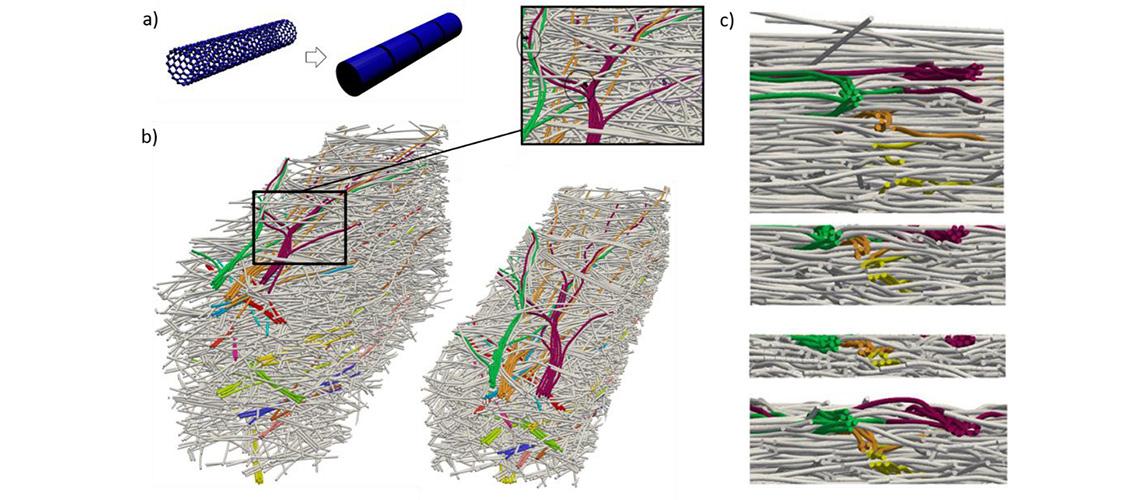Simulations to Study the Properties of Carbon Nanotubes
Carbon nanotubes (CNTs), which are a form of carbon with a cylindrical nanostructure, are an order of magnitude stronger than any other current engineering fiber. It has been, however, a challenge to fully utilize their potential for manufacturing superstrong composite materials. It is potentially possibl e to identify optimal designs for these materials using computer simulations, but the complexities of simulating CNTs are computationally prohibitive for molecular dynamics methods and are inaccessible by finite-element modeling. The research group of MSI PI Traian Dumitrica (professor, Mechanical Engineering) has developed a method called the mesoscopic distinct element method (mDEM) bridges this gap and makes computations efficient and extremely accurate.
A member of the Dumitrica group, Grigorii Drozdov, a 2020 UMII MnDRIVE PhD Graduate Assistant, used mDEM on a project called “’Fiber Flow’: Advancing Manufacturing of Carbon Nanotube Composites by a Computationally-Guided Approach.” The project investigated nanometer-thin single-walled CNT films collected from aerosol chemical deposition reactors, which have promising applications. A process called “densification” is an important way to manipulate mechanical, electronic, and optical properties. In order to discover the underlying microstructural level restructuring of CNTs during densification, large-scale vector-based mDEM simulations were performed in conjunction with electron microscopy and spectroscopic ellipsometry characterizations. Some of the computations in this project used the Mesabi cluster at MSI.
The UMII MnDRIVE Graduate Assistantship program supports UMN PhD candidates pursuing research at the intersection of informatics and any of the five MnDRIVE areas:
Robotics, Sensors and Advanced Manufacturing
Global Food Ventures
Advancing Industry, Conserving Our Environment
Discoveries and Treatments for Brain Conditions
Cancer Clinical Trials
This project is part of the Robotics, Sensors, and Advanced Manufacturing MnDRIVE area. Publications resulting from this work include:
Xu, Hao, Drozdov, Grigorii, Park, Jin Gyu, Jensen, Benjamin D., Wise, Kristopher E., Liang, Zhiyong, Odegard, Gregory M., Siochi, Emilie J., Dumitrica, Traian. Computationally guided design of large-diameter carbon nanotube bundles for high strength materials. ACS Applied Nano Materials 4(10): 11115-11125 (2021). doi: 10.1021/acsanm.1c02582
.
Hu, Chongze, Dernov, Andrei, Xu, Hao, Drozdov, Grigorii, Dumitrica, Traian. Ab initio predictions of graphite-like phase with anomalous grain boundaries and flexoelectricity from collapsed carbon nanotubes. Journal of Chemical Physics 154: 044701 (2021). doi: 10.1063/5.0038666.
Onuoha, Chinomso, Drozdov, Grigorii, Liang, Zhiyong, Odegard, Gregory M., Siochi, Emilie J., Dumitrică, Traian. Computational investigation of large diameter carbon nanotubes in bundles for high strength materials. ACS Applied Nano Materials 3(6): 5014-5018 (2020). doi: 10.1021/acsanm.0c1462.
Drozdov, Grigorii, Ostanin, Igor, Xu, Hao, Wang, Yuezhou, Dumitrică, Traian, Grebenko, Artem, Tsapenko, Alexey P., Gladush, Yuriy, Ermolaev, Georgy, Volkov, Valentyn S., Eibl. Sebastian, Rüde, Ulrich, Nasibulin, Albert G. Densification of single-walled carbon nanotube films: Mesoscopic distinct element method simulations and experimental validation. Journal of Applied Physics 128: 184701 (2020). doi: 10.1063/5.0025505.
The project was also presented at the International Conference on the Science and Application of Nanotubes and Low-Dimensional Materials, held at Rice University, Houston, Texas on June 6-11, 2021.

Image description: a) Coarse graining of the atomistic representation of a CNT into mesoscopic distinct elements. b) A region in the middle of the film before and after densification showing the reduction in film thickness. The callout shows the arrest of zipping of the branches to the main one caused by excluded volume interactions (black ovals and arrows) and by zipping of these branches to other bundles (purple oval and arrow). Colors show distinct bundles. c) A region located near the top surface at different stages of compression (top to bottom – 0%, 50% and 75% strain) and in the recovered film. The color is used to distinguish the evolution of existing bundles (green, orange, maroon,) and formation of a new bundle (yellow) and bundle-bundle zipping (yellow and orange).